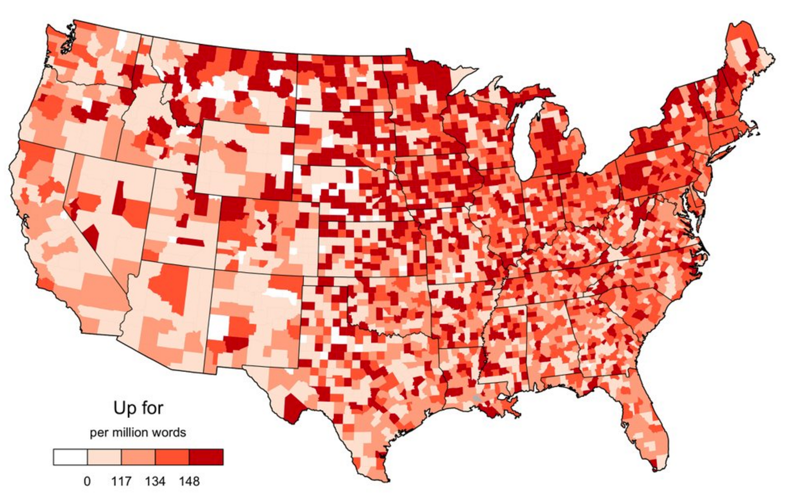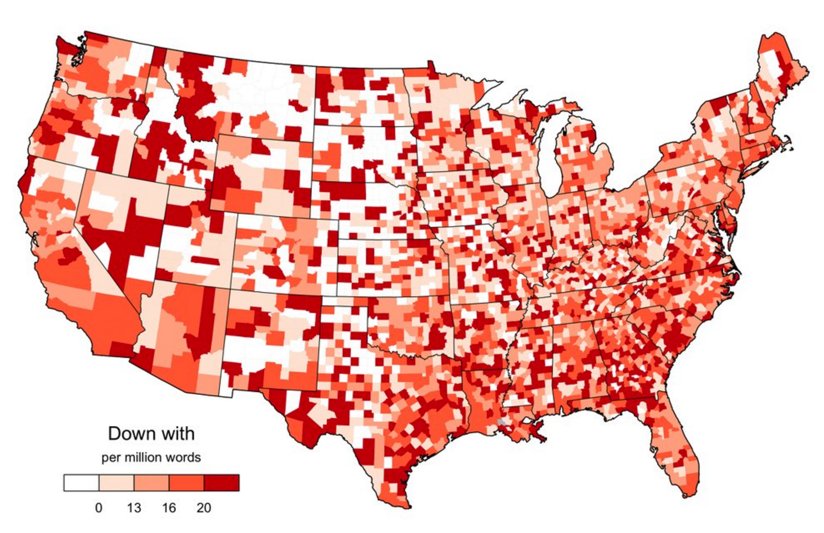Down with vs. Up for: We have maps
« previous post | next post »
From Jack Grieve, in response to "Up (for) and down (with)", 3/17/2016:
By request for Mark Liberman @LanguageLog: "Down with" vs. "Up for"…a rough North vs. South pattern pic.twitter.com/t4kfZLpi3v
— Jack Grieve (@JWGrieve) March 29, 2016
 |
 |
Jerry Friedman said,
March 29, 2016 @ 3:13 pm
Does that show just usages like "I'm up for that" and "I'm down with that", not "He fell down with a thump" and "She glanced up for a second"?
I think of "up for" as Californian, probably for no good reason, so it's interesting that "down with" is more popular there.
Gregory Kusnick said,
March 29, 2016 @ 3:15 pm
Almost as much of an east-west pattern as a north-south pattern.
But this seems to ignore the difference, brought up in the previous thread, between "up for", which suggests participation, and "down with", which signals approval. The Supreme Court is down with same-sex marriage but (I'm guessing) not personally up for it.
Imran Ahmed said,
March 29, 2016 @ 3:22 pm
I would be interested in seeing these stats for "down for" as well; I think I hear it more than either of the others. (From Long Island, 27 year old.)
J. W. Brewer said,
March 29, 2016 @ 3:31 pm
If the general consensus from the earlier thread that "down with" had started as an AAVEism was correct, one might look to see if it still was to some extent, which would mean a combination of most-of-south and urban-north. But I'm not seeing the second half of that prediction leap out of me from the map.
andyb said,
March 29, 2016 @ 6:31 pm
@Jerry Friedman: It's not inconceivable that "up for" was originally a Californianism, but it's now less common there than elsewhere. I think that's true of, for example, "way" for "very".
dw said,
March 29, 2016 @ 7:04 pm
@Gregory Kusnick:
Justice Ruth Bader Ginsberg has officiated at a same-sex marriage.
Rubrick said,
March 29, 2016 @ 10:17 pm
I'm curious* what percentage of "up for" instances come from the not-relevant phrase "up for reelection". If it's significant, it could partly explain the prevalence of "up for" in more densely populated areas (which have correspondingly more elected offices).
*Not curious enough to check, of course.
LL said,
March 30, 2016 @ 2:06 am
I remember YT video presenting a social experiment (checking people's reaction on LA streets) and everyone said "I'm down" as a negation. Does this have to do anything with that?
Barrie England said,
March 30, 2016 @ 2:46 am
As many will no doubt know, the conceptual metaphor, such as the figurative use of ‘up’ and ‘down’, was explored by Lackoff, Johnson and Turner in their ‘Metaphors We Live By’. In brief and inadequate summary, they argue that metaphorical understandings are not idiosyncratic or one-off, but are organised systematically. They suggest that it is possible to establish links between different metaphorical systems: thus, ‘up’ is generally positive and ‘down’ negative. For them, metaphor is not simply a way of talking or writing about something: metaphorical systems are associated with cultural preoccupations and with the ways members of specific cultures perceive and understand phenomena and act upon the world.
On the matter of maps, Norman Davies in his book ‘Europe’ prints all maps of the continent on a west-east axis rather than a north-south axis. It provides a strikingly different perspective.
Doug Henning said,
April 8, 2016 @ 11:50 am
I typically maintain a semantic difference here, in that I am "down with" something I like or am willing to do (stative, tolerant or agreeing) but "up for" something fun (prospective, enthusiastic). More often, I am probably "not up for" something (prospective, unenthusiastic).
I wonder how widespread this aspectual and semantic contrast is and whether it would show up in the data.